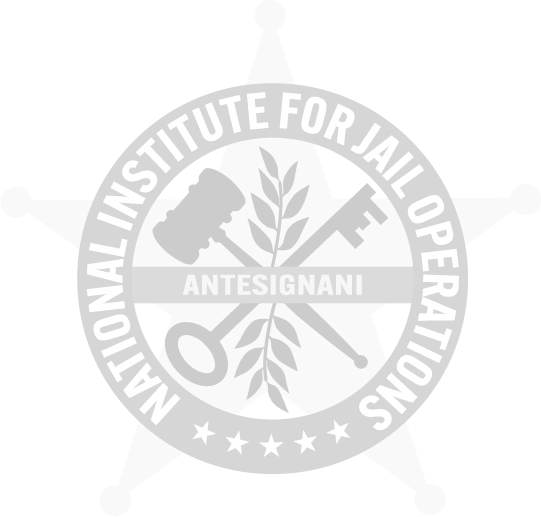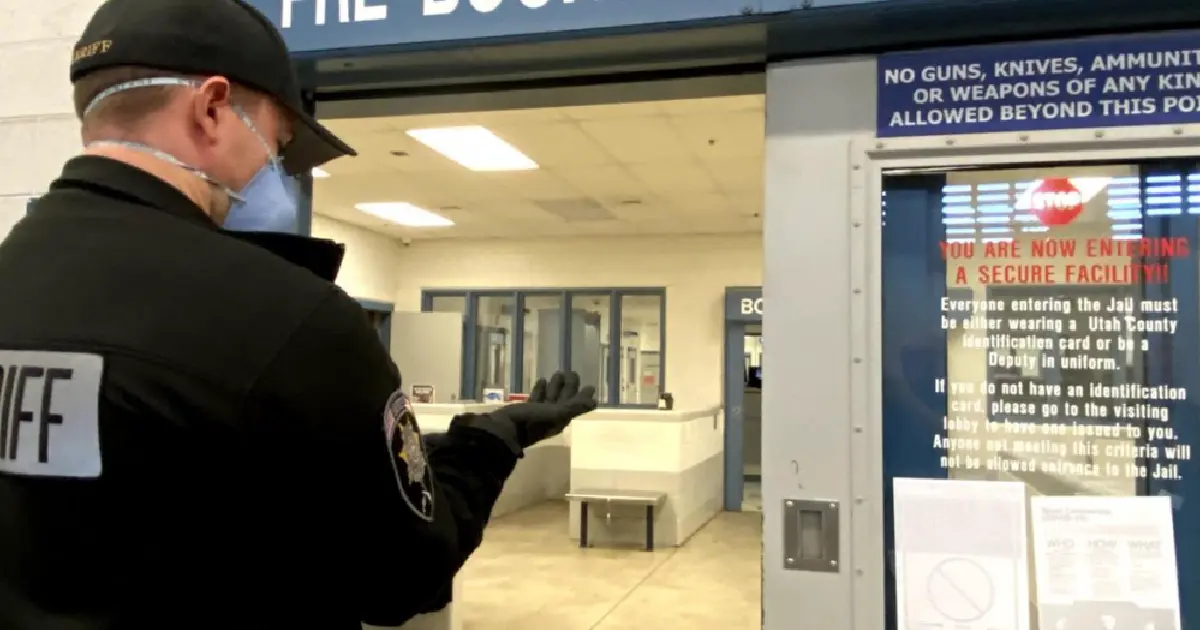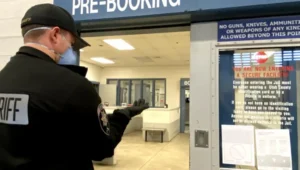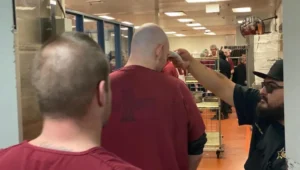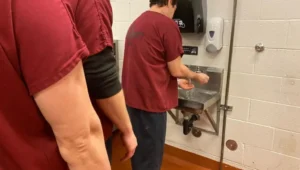By Tate McCotter, Executive Director
National Institute for Jail Operations
Many correctional facilities across the country have been operating short staffed, overpopulated and challenged in caring for a mentally ill population that has no business being in their facilities. Resilient administrators have done the best they can with what few resources they have under these trying circumstances.
And now here comes Coronavirus … as if the environment for correctional administrators wasn’t hard enough already, right? Where are the gloves? Where is the sanitizer? Where is the personal protection equipment for staff that no suppliers seem to have available? Correctional health care providers are being informed by pharma providers of a shortage for commonly prescribed medications for inmates such as Amoxicillin, Loratadine, Ibuprofen, and Diphenhydramine.1 At least we don’t have to worry about inmates complaining shortage of toilet paper … Limited supply chains are not unique to the corrections profession and law enforcement, but they are certainly being scrutinized under a different and higher standard.
Much of the media and inmate advocate groups pounced on the opportunity to promote organizational agendas, portraying correctional facilities as ill-equipped “cesspools” and “incubation chambers” to handle COVID.2 The Prison Policy Initiative kicked out five policy changes on the back of the coronavirus.3 These included releasing medically fragile and older adults (regardless of conviction/classification), stop charging medical co-pays, lowering jail admissions, reducing unnecessary parole and probation meetings and eliminating parole and revocations for technical violations. Their position did not change even after a parolee in Utah released early due to COVID-19 broke into a house, tied up a woman at knifepoint with shoelaces and threatened to cut her head off if she did not provide him her bank cards, cash, car and PIN numbers.4 Some inmates in facilities have reported they do not wish to be released early because they are “safer” in the facility and better equipped and prepared to deal with the virus than the outside.
The ACLU sent Wyoming sheriffs formal letters requesting their COVID-19 plans and the adoption of measures5 to combat the “risk of spreading coronavirus” which, among others, included:
- Cease community sweeps, raids and transporting ICE detainees;
- Staffing levels be maintained (acknowledging some staff may be infected and required to stay at home quarantined);
- Request for screening and testing procedures;
- Data collection shared to the public;
- Housing for individuals exposed to the virus should not result in “prolonged, widespread lockdowns;
- Immediate access to treatment;
- Additional precautions required for “vulnerable populations” including inmates “whose housing placements limit the staff’s ability to observe them” and those with chronic illnesses (some stats say this is 40% of the population); and
- Visitation to include video calls, eliminate charges for phone and video calls during the period, and lift or modify limits on phone calls.
All of these unique and sensationalized events and publicity create panic with the public, entitlement with inmates and anxiousness among staff and administrators. The demands being placed upon correctional administrators are not only impossible to enact given the limited and varying facilities and resources, they are also unreasonable, far exceed the requirements of care given to the general public and may threaten the safety and security of fellow inmates, staff and communities. Perhaps more alarming is the increased potential liability they might place on correctional agencies if enacted.
This global pandemic has adversely affected every individual in this country but what exactly does a pandemic bring that is new legally? Are administrators suddenly more legally liable because of a global panic? Where is the balance between inmate rights and protecting the penological interests of the facility? It is no secret game plan for inmates and their attorneys to try to make money on the backs of taxpayers by a threatened lawsuit or quick settlement, especially in uncertain times. While the threat of a lawsuit may cause alarm, it is critical that administrators remain calm and use common sense as it relates to proactively managing COVID-19.
Even under the best of circumstances, emergency situations tax the capability of persons to respond in a satisfactory, timely, and effective manner; however, in a jail the difficulty of emergency responses is exacerbated.6 The nature of inmates makes the situation even more dangerous. First responders in a correctional setting who engage in emergency operations must interact with a high-risk population under very demanding and unforgiving conditions. The potential for death or serious injury of staff, inmates, and other persons in the jail is substantial. Unlike the public community where individuals can shelter at home, evacuation and decreasing population sizes are limited options.
Here are a few basic principles to provide guidance in decision making with some of the frivolous demands, requests, complaints and threats correctional administrators are undoubtedly receiving related to coronavirus.
Qualified Immunity Defense.
Case law is not determined or established by an organizations’ recommendations, policies, or procedures – even if they are well-intentioned and useful. The Supreme Court has repeatedly reminded lower courts that such standards do not set constitutional minima and merely reflect the goals and objectives of the organizations that created them.8 Federal or specific state legislation may dictate actions required related to COVID-19, which will be required to follow by correctional administrators. Good faith qualified immunity defense depends on knowing and complying with clearly established law.7 Qualified immunity is a defense to civil rights suits that insulates government officials from liability unless they violate “clearly established statutory or constitutional rights of which a reasonable person would have known.” The Supreme Court provides an expansive view of qualified immunity protection for correctional officials, imposing a high bar for showing that conduct violates clearly established law. Prior case law must define the established right with sufficient particularity, and that definition must correspond to the facts of the case at hand.9 Unless there are new rulings or legislation passed pertaining to communicable diseases and correctional institutions, administrators are required to meet current statutory and constitutional rights.
Note that even if new case law was quickly established by a court governing COVID-19 and communicable diseases, the question of whether a new law takes time to become “clearly established” has been questioned among courts. The 3rd Circuit 2019 decision Bryan v United , for example, addresses that issue, with Judge Roth ruling action taken two days following a ruling was not enough time to make it “clearly established” and therefore granted officers qualified immunity.10
8th Amendment, Deliberate Indifference and Failure to Protect Defense.
Inmates and attorneys commonly state Eighth Amendment, Deliberate Indifference and Failure to Protect allegations intertwined with medically related lawsuits. Considering diagnosing and treating COVID-19 or any medical condition, correctional administrators have an obligation to provide reasonable and adequate care. The Constitution does not require perfect treatment. As the 10th Circuit noted, officials “do not guarantee that inmates receive absolutely correct medical treatment, as there is no such thing, and everyone takes a risk as to diagnosis and treatment.”11
Correctional officers are not medical experts and there is much yet to be learned and discovered with this virus. Barring clairvoyance and the ability to see the future, correctional officials and medical staff must rely primarily on information gathered at intake, much of which is provided by the arresting officers and arrestees themselves. Proactive efforts and measures, such as taking temperatures, wearing PPE, sanitation and excessive handwashing by all can and should be enacted by facilities to try to detect, prevent and respond to a communicable disease like COVID-19; however, those best faith efforts are subject to limitations and error just like in the public.
An administration’s reasonable efforts to provide adequate and timely health care which do not demonstrate deliberate indifference to the health and safety of inmates should be protected from inmate-filed claims of deprivation of constitutionally required medical care. The U.S. Supreme Court ruled that negligence alone does not create a constitutional claim.12 The requirement for culpability is deliberate indifference.13 For health care to violate the Eighth Amendment it must involve more than ordinary lack of due care for the inmate’s interests or safety.
According to the Court, a physician’s negligence in diagnosing or treating a medical condition does not suffice to make out a constitutional claim. A constitutional claim requires that officials acted with “obduracy and wantonness, not inadvertence or error in good faith . . . whether that conduct occurs in connection with establishing conditions of confinement, supplying medical needs, or restoring official control over a tumultuous cellblock.”14
To establish a successful Eighth Amendment deliberate indifference COVID-19 claim, the inmate must prove by a preponderance of evidence that correctional officials:
- Knew of the inmate’s serious medical condition and its substantial risk (i.e., a positive test of COVID-19);
- Knowingly or recklessly disregarded that risk by failing to take reasonable measures to abate it (i.e., officials and staff did nothing about that known actual COVID-19, such as failure to provide treatment/hospitalization if necessary, separate them to the best of their ability from other inmates); and
- Caused the inmate serious harm or unnecessary pain and suffering due to staff’s action or inaction.15
The absence of serious injury is relevant to the Eighth Amendment inquiry, but does not end it.” 16 Officials cannot act maliciously and sadistically to cause harm, otherwise contemporary standards of decency are violated. This is true whether or not significant injury is evident. However, recognizing COVID-19 can be community spread from inmate to inmate, the Court also ruled that liability does not attach to every inmate injury stating “It is not, however, every injury suffered by one prisoner at the hands of another that translates into constitutional liability for prison officials responsible for the victim’s safety.”17
Failure to protect allegations related to the coronavirus are commonly used as justification for demands by inmates and advocate right groups. The 8th and 14th Amendments impose duties on corrections officials, who must take reasonable measures to guarantee the safety of the inmates.18 Specifically mentioned medical care, the Court stated
“[W]hen the State by the affirmative exercise of its power so restrains an individual’s liberty that it renders him unable to care for himself, and at the same time fails to provide for his basic human needs–e.g., food, clothing, shelter, medical care, and reasonable safety–it transgresses the substantive limits on state action set by the Eighth Amendment and the [Fourteenth Amendment’s] Due process Clause.” 19
Does this mean that facilities should be providing every inmate coronavirus testing, personal masks, five rolls of toilet paper, or even more controversial, future vaccinations? Of course not! Every facility has different and very limited resources which makes a one-size-fits-all approach to pandemic management impossible. We must do the best we can with what resources we have… in other words, TRY!
The Swine Flu pandemic hit the United States in 2009 and resulted in inmate-filed litigation against correctional officials which provides a solid foundation for proactive defense to beat deliberate indifference and duty to protect claims. Adequate, timely and reasonable steps taken to prevent and address the Swine Flu in facilities provided administrations defense even when inmates were exposed and contracted COVID-19.20
In one particular case against the New York Department of Corrections, the court ruled “mere exposure to swine flu does not involve an unreasonable risk of serious damage to … future health.”21 In another case, agencies were able to defend claims showing increased sanitation efforts to slow and minimize the spread of the swine flu.22
Documentation of Action.
To be defensible, correctional officials need to be able to show proof of efforts made to address known risks, even if those “trying” efforts are not ideal or even effective. Some examples of actions taken by facilities are listed below, many of which can be implemented in facilities varying is size and access to community resources.
- Ensure emergency and contingency plans include pandemic emergencies.23 COVID-19 provides opportunity for administrations to test drive existing policies and make proactive adjustments.
- Identify and track inmates who may be at higher risk (existing medical conditions i.e., diabetes, lung disease, heart issues; age over 60) and take proactive measures to mitigate risk. While classification changes or early release may be limited options for administrations, it can be a temporary option. “Quarantine” sick inmates using medical isolation may also be helpful. In the event an inmate shows symptoms, timely action and medical treatment is critical before the inmate becomes extremely ill, suffers serious complications to pre-existing conditions or results in an in-custody death.
- Provide inmates and staff education on how to properly wash their hands, general hygiene and social distances.
- Increase attention to sanitation to prevent the introduction and spread of COVID-19 (i.e., doors, kiosk screens, shared water fountains and other high traffic areas).
- Minimize exposure risk and contact by temporarily limiting personal visitation, transport, work release, and recreation.
Constitutional Rights Temporarily Delayed or Suspended.
Administrators must maintain order, especially in a time of crisis. Tension and increased stress caused by COVID-19 will be experienced by inmates and staff. In order to keep inmates, staff and the public safe, facilities will have to enact temporary measures to combat coronavirus that may be unpopular with the inmates. Recently in Brazil, inmates claimed it was coronavirus as the cause for their mass riots, which resulted in an estimated 1000 escapes from four facilities, although no confirmed cases had been reported at the time.24 Inmates stated it was increased lockdown, suspended visitation and exercise time that sparked the anger. Dislike for a temporary policy change should be expected by administrations but an inmate’s dislike does not provide grounds for disobeying facility rules and regulations.
Correctional officials will necessarily need to adopt and implement temporary changes to operational practices. When modifying an existing policy and procedure to accommodate such changes, rationale is critical. Rationale is the key to successfully defending policies, decisions, and actions in the litigious corrections environment.25 It also is useful to logically explain to inmates, staff, the public, and perhaps even used in litigation defense why delays or changes in usual procedures were determined under these unique circumstances.
- Use of Solitary Confinement. Many inmate advocate groups, media and politicians have in the last decade promoted a complete abolishment of its use. Now those same groups have reversed course and are demanding facilities to separate and isolate inmates for their safety. The use of administrative segregation has been defended in courts and a pandemic does not change an administration’s deference to enact its use. Such flexibility was reiterated during the Swine Flu crisis, where a facility successfully defended an Eighth Amendment claim by placing an inmate in medical isolation after the inmate refused to undergo tuberculosis screening.26 Unfortunately, many facilities have been built and designed with more open space and dormitories, ignoring the need for single cells, which would be beneficial to manage a population dealing with communicable diseases. For administrations looking to build a new facility or remodel, this circumstance may serve helpful).
- Personal Visitation. Communication is a Constitutional right; however, visitation is only one of many ways which an inmate can communicate.27 Mail and telephone can also serve as a way to meet that right. As the Supreme Court stated, “the freedom of association is among the rights least compatible with incarceration.”28 To mitigate risk and exposure especially to facilities which do not have the technology to provide video visitation, personal visitation may be temporarily suspended. Alternatives are not necessarily required but can be provided if resources allow, such as providing longer telephone time, extra stamps for inmates, etc.
- Correctional officials and medical staff who works in the jails are considered “essential” staff. In many states where non-essential businesses and employees were required to shut down, stay at home, or are given options to work remotely, correctional officials and medical personnel in facilities do not have that option. Staffing is essential to the operations, safety and security of the community and the necessity for adequate staffing to avoid deliberate indifference and failure to protect claims is obvious. Staffing may be perhaps the most difficult issue facing administrators during this pandemic.
Staffing shortages in numerous facilities were widespread before coronavirus hit. Many were already operating on skeleton staffing requiring mandatory overtime. Beyond high turnover and low morale during a crisis, there are a number of reasons which COVID-19 may further exacerbate existing staffing issues which correctional administrators should be aware of and, if possible, address.
- “Quarantine” Effect. COVID-19 can be introduced into a facility two ways: staff or inmates. While facilities may do their best to ascertain whether staff may be symptomatic, some may not show signs and still be carriers. Recommendations that require symptomatic individuals to be quarantined for 14 days will create a staffing hardship undoubtedly. Staff is not easily replaced. This will be worsened for those agencies that require any individual who has had contact with someone who has been symptomatic. If an officer tests positive, this could potentially put an entire shift on “quarantine.”
- Families First Coronavirus Response Act (FFCRA). As part of this emergency act enacted by Pres. Trump, effective April 1, 2020, Extended Family and Medical Leave (EFMLA) and Emergency Paid Sick Leave provides certain and extensive employee and financial benefits. Unless addressed adequately by governmental agencies and administrations, it can be anticipated and expected some staff to seek after and apply for these benefits, which would allow them to leave their workplace “to care for a child” (i.e., due to quarantine, school closures,) and apply for emergency sick pay. Hopefully, FFCRA will provide meaningful compensation and attention to our first responder correctional officers but that has yet to be determined.
- Staff Burnout. With tensions high at home and work, mandatory overtime enforcements and increased responsibilities to address coronavirus, burnout among staff may be inevitable. Administrators should be aware and do whatever they can do strive to create a positive work environment. Emotional intelligence and leadership is extremely critical in a time of crisis, along with a chunk of creativity and outside the box thinking. Although less than ideal, some agencies may consider temporary staffing solutions.
Unfortunately, there are few solutions to staffing issues that can be quickly resolved by correctional administrations. Hiring and retention has long plagued the corrections profession due to low salaries and few incentives to stay in the jail when the street side is paid higher and has established advancement tracks.
Other Common Issues.
As time goes on and if COVID-19 stays for a while, there may be other issues challenged by inmates, such as classification, due process, exercise and recreation, access to programming, religion and more. Exigent circumstances necessitate less than ideal responses to challenging situations. For those instances and specific issues, please refer to the NIJO Legal-Based Jail Guidelines to assist in determining rationale and legal requirements.29
CONTACT US:
The National Institute for Jail Operations (NIJO) was formed in 2011 as the primary resource dedicated to serve those that operate jails, detention and correctional facilities. Recognizing the enormous liability and increasing litigation facing administrators, NIJO provides a compilation of legal-based resources and information for agencies to make facilities safer and more secure, proactively defend against frivolous litigation, and protect against adverse publicity and liability. If you have questions about a specific training topic or are looking for more information about legal-based online training, national accreditation, certification, standards, technical assistance, or policy and procedure, don’t hesitate to ask. Contact info: support@jailtraining.org
CONTACT US:
- Bates, Johnny. (2020, March 19). Personal interview.
- Kaste, Martin. (2020, March 13). NPR Radio. Prisons and Jails Worry About Becoming Coronavirus ‘Incubators.’ https://www.npr.org/2020/03/13/815002735/prisons-and-jails-worry-about-becoming-coronavirus-incubators; Francescani, Chris and Barr, Luke. (2020, March 19). ABC News. ‘Fearing Outbreaks and Riots, Nation’s Prison and Jail Wardens Scramble to Respond to Coronavirus Threat.’ https://abcnews.go.com/Health/fearing-outbreaks-riots-nations-prison-jail-wardens-scramble/story?id=69676840
- Wagner, Peter and Widra, Emily. (2020, March 6). Prison Policy Initiative. https://www.prisonpolicy.org/blog/2020/03/06/pandemic/
- Reavy, Pat. (2020, March 24). KSL. ‘Parolee Released Early Due to COVID-19 Breaks Into House, Threatens Woman With Knife, Police Say.’ https://www.ksl.com/article/46733772/parolee-released-early-due-to-covid-19-breaks-into-house-threatens-woman-with-knife-police-say
- Serrano, Antonio. (March 24, 2020). COVID-19 and the Criminal Justice System Letter ACLU of Wyoming.
- See NIJO Legal-Based Jail Guidelines F06.02.01 Emergency Plans https://jailtraining.org/guidelines/
- Harlow v. Fitzgerald, 457 U.S. 800, 818 (1982). The Court’s exact phrasing of clearly established law differs depending on the case. See also Plumhoff v. Rickard, 572 U.S. 765, 778 (2014) (requiring “a statutory or constitutional right that was ‘clearly established’ at the time of the challenged conduct” (quoting Ashcroft v. al-Kidd, 563 U.S. 731, 735 (2011))), with Ziglar v. Abbasi, 137 S. Ct. 1843, 1866 (2017) (requiring “legal rules that were clearly established at the time [the action] was taken” (alteration in original) (internal quotation marks omitted) (quoting Anderson v. Creighton, 483 U.S. 635, 639 (1987)))
- See Bell v. Wolfish, 441 U.S. 520, 543 n.27 (1979); Rhodes v. Chapman, 452 U.S. 337, 350 n.13 (1981). Also see Gregg v. Georgia, 428 U.S. 153, 173 (1976) (joint opinion).
- See, e.g., al-Kidd, 563 U.S. at 742 (“We have repeatedly told courts . . . not to define clearly established law at a high level of generality.”).
- Bryan v United States 913 F.3d 356 (CA3. 2019)
- Gomm v. DeLand, 729 F.Supp. 767, 782-783 (D. Utah 1990), quoting McCracken v. Jones, 562 F.2d 22, 24 25 (CA10 1977), cert. denied, 435 U.S. 917 (1978).
- Daniels v. Williams, 474 U.S. 327, 330-332 (1986).
- Farmer v. Brennan, 511 U.S. 825, 837-839 (1994).
- Estelle v. Gamble, 429 U.S. 97, 105 106 (1976).
- Estelle v. Gamble, 429 U.S. 97 (1976); Ancata v. Prisoner Health Services, Inc., 769 F.2d 700, 704 (CA11 1985); Gomm v. DeLand, 729 F.Supp. 767, 778 (D. Utah 1990), affirmed, 931 F.2d 62 (1991)
- Hudson v. McMillian, 503 U.S. 1, 6 (1992), quoting, Whitley v. Albers, 475 U.S. 312, 321 (1986).
- Farmer v. Brennan, 511 U.S. 825, 834 (1994).
- Farmer v. Brennan, 114 S.Ct. 1970, 1989 (1994), quoting Hudson v. Palmer, 468 U.S. 517, 526-527 (1984). See Helling v. McKinney, 113 S.Ct. 2475, 2480 (1993); Washington v. Harper, 494 U.S. 210, 225 (1990); Cf. DeShaney v. Winnebago County Dept. of Social Services, 489 U.S. 189, 198-199 (1989). See also, 2d Restatement, Torts, 867 Section 320.
- DeShaney v. Winnebago County Department of Social Services, 489 U.S. 189, 198 (1989).
- Jackson v. Rikers Island Facility, 2011 WL 3370205, **2-3 (S.D.N.Y. Aug. 2, 2011).
- Glaspie v. New York City Dep’t of Corr., 2010 WL 4967844, *1 (S.D.N.Y. Nov. 30, 2010).
- Ayala v. NYC Dep’t of Corr., 2011 WL 2015499, *2 (S.D.N.Y. May 9, 2011)
- See NIJO Legal-Based Jail Guidelines F06.02.05 Contingency Plans Required https://jailtraining.org/guidelines/
- Schladebeck, Jessica. (2020, March 17). New York Daily News. ‘Hundreds of Inmates Escape From at Least Four Different Brazil Prisons Amid Coronavirus Panic.’ https://www.nydailynews.com/coronavirus/ny-coronavirus-brazil-prison-hundreds-escape-easter-20200317-qaukwqilq5ajhoa23fwfn3jnym-story.html
- Turner v. Safley, 482 U.S. 78 (1987).
- Jones-Bey v. Wright, 944 F. Supp. 723 (N.D. Ind. 1996)
- Kentucky Department of Corrections, 490 U.S. 454, 460 (1989).
- Overton v. Bazzetta, 539 U.S. 126, 131 (2003) (internal citations omitted; emphasis added).
- See generally, NIJO Legal-Based Jail Guidelines https://jailtraining.org/guidelines/

